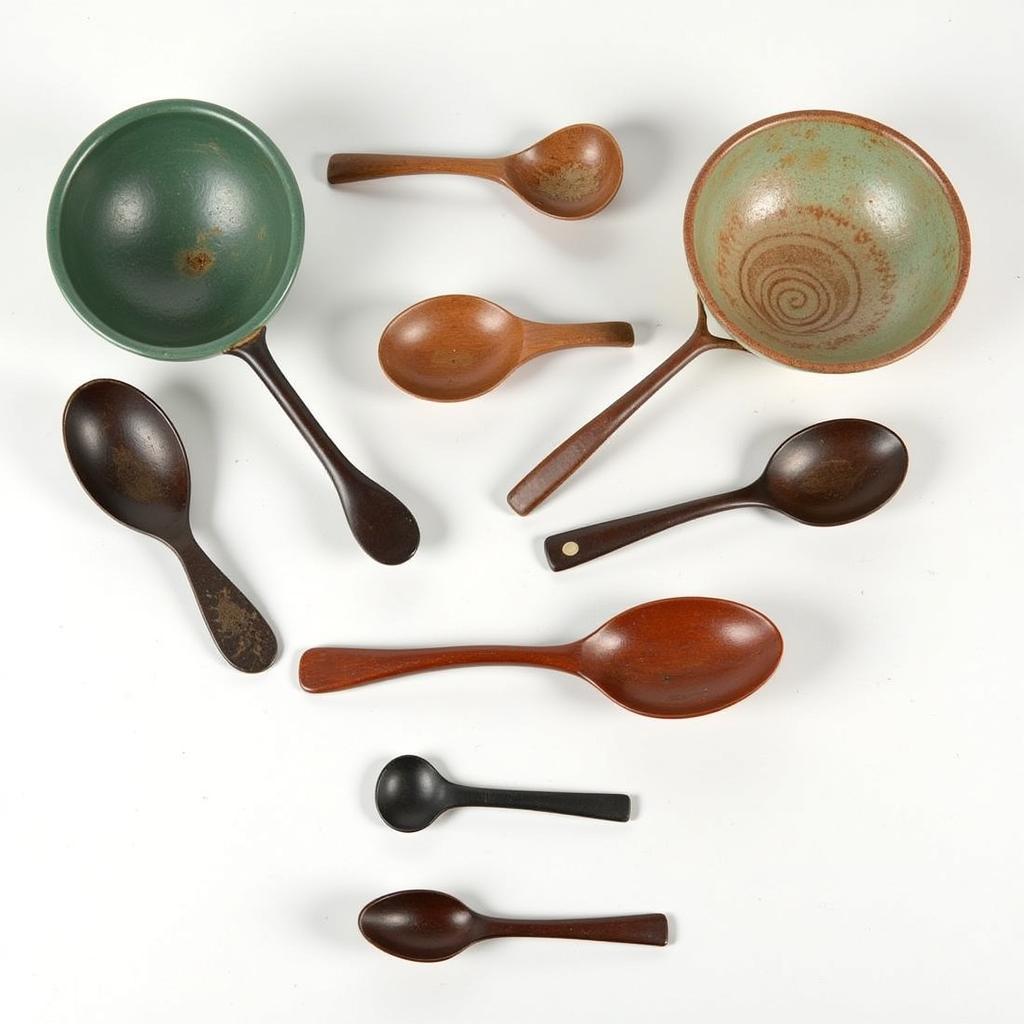Asian cuisine is renowned for its diverse flavors, vibrant colors, and unique ingredients. But what truly enhances the dining experience is the artful use of Asian Food Utensils. From the delicate precision of chopsticks to the versatile functionality of spoons and bowls, these tools are integral to appreciating the rich tapestry of Asian culinary traditions. Let’s embark on a journey to discover the fascinating world of asian food utensils, exploring their history, cultural significance, and practical uses. We’ll even delve into how these utensils elevate the enjoyment of specific dishes, turning each meal into a celebration of taste and tradition. Read on to discover the magic that lies beyond the plate!
For those looking to create an authentic Asian dining experience at home, consider our curated asian food gift box.
Chopsticks: An Icon of Asian Dining
Chopsticks, perhaps the most recognizable asian food utensil, have a history spanning millennia. Originating in ancient China, they have become synonymous with many East and Southeast Asian cultures. While their primary function is to pick up food, chopsticks are much more than mere tools. They represent dexterity, grace, and a connection to culinary heritage.
The Art of Using Chopsticks
Mastering the art of using chopsticks can be a rewarding experience. It involves a delicate dance of fingers, applying just the right amount of pressure to secure food without dropping it. The proper technique involves holding one chopstick stationary while maneuvering the other to grasp and lift the morsels.
 Different Types of Chopsticks in Asian Cuisine
Different Types of Chopsticks in Asian Cuisine
Spoons and Bowls: The Foundation of Asian Meals
While chopsticks often steal the spotlight, spoons and bowls play a fundamental role in Asian dining. These utensils are essential for enjoying soups, stews, rice dishes, and noodles. From the deep, rounded bowls used for ramen to the smaller, delicate spoons designed for sipping tea, each utensil has a specific purpose and adds to the overall dining experience.
Beyond the Basic Bowl: Regional Variations
The shape and size of bowls and spoons vary significantly across different Asian regions, reflecting the unique culinary traditions of each area. For instance, the shallow, wide-rimmed bowls used for serving Korean bibimbap contrast sharply with the deep, cylindrical bowls favored for Japanese ramen.
 Variety of Asian Spoons and Bowls
Variety of Asian Spoons and Bowls
Other Essential Asian Food Utensils
Beyond chopsticks, spoons, and bowls, numerous other utensils contribute to the rich tapestry of Asian dining. These include:
- Ladles: Used for serving soups and stews.
- Serving Chopsticks: Larger than eating chopsticks, these are used for serving food from communal dishes.
- Mortar and Pestle: Essential for grinding spices and creating flavorful pastes.
- Cleavers: Used for chopping vegetables and meats.
- WoKs: The iconic curved pan used for stir-frying and other cooking techniques.
If you’re looking to enhance your dining setup, a buffet food table can be a great addition to showcase your Asian culinary creations.
The Role of Utensils in Specific Dishes
Certain asian food utensils are specifically designed for particular dishes, highlighting the intricate relationship between food and tools. For instance, the slotted spoon is perfect for retrieving dumplings from boiling water, while the long-handled chopsticks are ideal for cooking and serving hot pot.
A hot food bar equipped with the right utensils can significantly elevate the presentation and enjoyment of Asian dishes.
Conclusion
Asian food utensils are more than just tools for eating; they are an integral part of the cultural and culinary landscape. Understanding their significance and proper use enhances the dining experience, allowing you to fully appreciate the rich traditions and flavors of Asia. From the elegant simplicity of chopsticks to the versatile nature of spoons and bowls, asian food utensils are a testament to the ingenuity and artistry of Asian culinary practices. By embracing these tools, we not only savor the delicious food but also connect with the vibrant cultures that have shaped them. If you’re interested in exploring the culinary world of Japan, check out our range of food truck for sale japan.
FAQ
- What are the different types of chopsticks? Common materials include bamboo, wood, plastic, metal, and even ivory or jade for special occasions.
- Why are spoons important in Asian cuisine? Spoons are essential for enjoying soups, stews, congee, and even some noodle dishes.
- What is the significance of the wok in Asian cooking? The wok’s unique shape allows for quick and even cooking, essential for stir-frying and other high-heat techniques.
- How do I learn to use chopsticks correctly? Practice is key! Start with simple exercises and gradually progress to more challenging foods.
- Where can I find high-quality Asian food utensils? Specialty Asian grocery stores, online retailers, and even some department stores offer a wide selection.
Common Scenarios
-
Scenario 1: You are hosting a dinner party featuring Asian cuisine and want to provide an authentic dining experience. Understanding the appropriate utensils for each dish, such as serving chopsticks for communal dishes and smaller spoons for individual portions, will enhance the overall presentation and cultural authenticity.
-
Scenario 2: You are traveling in Asia and want to show respect for local customs. Learning how to use chopsticks correctly and understanding basic table etiquette will demonstrate your cultural sensitivity.
-
Scenario 3: You are trying a new Asian dish for the first time and are unsure which utensils to use. Observing how others are eating or asking your server for guidance can help you navigate unfamiliar dining customs.
Further Exploration
- Explore different types of Asian noodles and the appropriate utensils for each.
- Research the history and cultural significance of tea ceremonies and the specific utensils used.
- Discover regional variations in Asian dining etiquette and utensil usage.
Need assistance? Contact us at Phone: 02437655121, Email: [email protected], or visit us at 3PGH+8R9, ĐT70A, thôn Trung, Bắc Từ Liêm, Hà Nội, Việt Nam. Our customer service team is available 24/7.